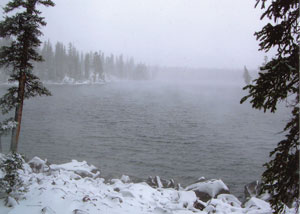Two seasons in 24 hours
A weekend filled with the joy of the great outdoors took its toll on the College of Eastern Utah wilderness studies class [humankind and the environment 1210 and 2010] as students ventured through the rough terrain of the high Uintas two weeks ago at 9,750 feet above sea level.
A three-day adventure was cut short by Mother Nature. This 4.2-mile hike started on Friday morning, September 15, as the class prepared for a weekend full of adventure and exploration. We left campus and headed for the mountains hoping for good weather, knowing a storm could possibly move in that night.

This archived article was written by: Ryan Leonard & Andrew Oyler
A weekend filled with the joy of the great outdoors took its toll on the College of Eastern Utah wilderness studies class [humankind and the environment 1210 and 2010] as students ventured through the rough terrain of the high Uintas two weeks ago at 9,750 feet above sea level.
A three-day adventure was cut short by Mother Nature. This 4.2-mile hike started on Friday morning, September 15, as the class prepared for a weekend full of adventure and exploration. We left campus and headed for the mountains hoping for good weather, knowing a storm could possibly move in that night.
As we arrived there seemed to be a light rain but it did not look to be a threat to our hike. We loaded our packs and started up the trail and everything seemed to be going pretty good. Hiking the mountain you could tell how being out of shape was not helping our situation, but the gorgeous landscaping made up for it.
The leaves had begun to change into their bold autumn colors. We climbed higher and it became colder and windy the closer we came to the crest. We approached the pass and drew close to our destination of Mohawk Lake; it was all down hill from the pass the rest of the way. The light rain from earlier that day had turned to a slight hail.
With about half a mile to go, we decided that it would be a little late in the day to reach Mohawk so we settled down and made camp on the shore of Betsy Lake at 10,420 feet above sea level. While we were setting up our tent, two big microbursts of thunder, lightning and hail came through camp and made a small layer of moisture on the ground.
After the weather calmed down, we made way to the lake to purify some drinking and cooking water. Some of us even found time to test out those important fishing skills at the lake.
As the night set in, some of the class gathered firewood to help keep us warm until we went to bed. After the sun went down and the fire had been burning a while, the day had caught up with the class and we moved towards bed, knowing that the rest of the trip would depend on that night’s weather.
Before we went to bed we looked in the sky and saw stars, a sure sign of clear skies. This little bit kept our hopes up for the rest of the trip. Tossing and turning in our sleeping bags trying to stay warm, the night seemed like it would never end and we would never see the sun shine through our tents.
When the sun finally did reach our camp, we would have rather never woke up then see what the night’s weather had bought us. We opened out tent and rain fly to find a white layer of snow six-inches thick on the once brown ground. At about 8:30 a.m. our instructor Nathan Wilson came around and told us to gather up our belongings so we could head out as soon as possible. By 10 a.m., everybody was packed and ready to head back down the trail. Our first task was to find the Grand View trail and get headed in the right direction. We would still be looking if it weren’t for the G.P.S that Wilson had with him. After we found the trail, it was smooth sailing down the mountain.
With a group that was eager to get back to the warmth of the van, we covered the first mile in one half hour. After we hiked over the crest of Hyades Pass, elevation 10,570, we found a place to stop and get a bite to eat, and then we headed back down the trail. With about a mile left to go, our group passed a man hiking in alone. We stopped and told the man about the snow on top and told him to be careful.
From there we continued down the final stretch that was all switchbacks. Upon arriving at the van, we all dropped out packs and began to hydrate ourselves. The drive back to the paved roads was going to be a slippery, muddy mess and we had to drive careful to stay on the roads. On top of the van was a thick layer of snow that kept falling on the hood. We tried hitting the brakes to get the rest of the snow off the top of the van but it wouldn’t budge. Finally, we got to a stretch of road that was safe and slammed on the breaks, sliding the snow from the top of the van onto the road.
The rest of the trip went without complications and we all made it safely back to Duchesne where we filled up on “real food”. As soon as everybody was done eating we made the road trip over Indian Canyon back to Price where the trip ended.
The group’s next adventure will be a 65-mile canoe trip down Labyrinth Canyon over fall break.




